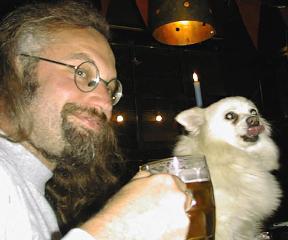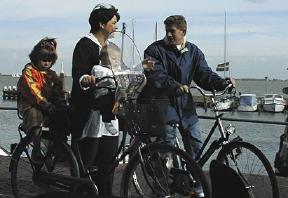
Amsterdam
May 6th - May 13th, 1999

There's always one place in Europe that everyone compares to our home town of San Francisco: Amsterdam. Both are small, compact cities with a flair for doing things differently and (at least trying) to view alternative perspectives on life. But whereas San Francisco doesn't live by some of the rules, Amsterdam doesn't live by any of the rules. Most Americans already know of the outlines of Amsterdam's history: founded nearly 800 years ago, surrounded by dikes and built almost entirely on land reclaimed from the sea, Amsterdam was once the seat of one of the world's greatest seafaring powers. The wealth of the spice islands (now Indonesia) enriched this little town and the glow of those days has yet to fade.
Walking around Amsterdam and slowly it begins to dawn on one why this town is so different. Built on 11 million wooden piers (essentially, 15 - 20 meter long telephone poles), Amsterdam is essentially a floating mat of biomass and bricks. Much like building a town on jello and supporting it with toothpicks. Thus, the physical environment of Amsterdam "wiggles" -- even more than our California earthquakes stir San Francisco. Right angles aren't, vertical isn't and solid ground floats. All the buildings in this crazy place tilt and whirl around, leaning on each other like brothers who've had a little too much to drink on Queensday. You don't need a trip to a coffee house to get dizzy walking around Amsterdam.
|
|
|
|
Amsterdam doesn't follow the European tradition of grand sights and monuments, but rather abounds with the small and unusual around every corner. Here Kathy takes a ride in a giant wooden shoe, Jim pets a Komodo dragon in a tulip garden, and we see two examples of canal life: a sea-faring houseboat with swivel keels and lovely canal side cafe seating.
Architecture, Amsterdam-style
 As most of the land underneath Amsterdam was reclaimed from the sea,
Amsterdam law and public policy encouraged as efficient use as possible
of that land. In particular, buildings were taxed by their width, thus encouraging
tall and narrow structures. Oftentimes this was carried to extremes: we
heard of one building that was two meters wide and three stories tall! Our
hotel on the edge of the red light district was a narrow affair with our
room at the top on the fifth floor. While this was wonderful in terms of
offering a relief from the bedlam below (only the mega-amplified rock parties
could touch our serenity), it meant that at least half a dozen times a day
we got to tromp up five sets of very space efficient Dutch stairs. We soon
came to lovingly refer to them as our "Dutch stairmaster."
As most of the land underneath Amsterdam was reclaimed from the sea,
Amsterdam law and public policy encouraged as efficient use as possible
of that land. In particular, buildings were taxed by their width, thus encouraging
tall and narrow structures. Oftentimes this was carried to extremes: we
heard of one building that was two meters wide and three stories tall! Our
hotel on the edge of the red light district was a narrow affair with our
room at the top on the fifth floor. While this was wonderful in terms of
offering a relief from the bedlam below (only the mega-amplified rock parties
could touch our serenity), it meant that at least half a dozen times a day
we got to tromp up five sets of very space efficient Dutch stairs. We soon
came to lovingly refer to them as our "Dutch stairmaster."
Remember that Amsterdam is built on 11 million telephone poles? Well,
an average size house would require somewhere between five and ten support
poles. Below to the left is one of the cylinders in which the pole would
ride and around which the house would be built. If the builder didn't use
enough poles, or improperly constructed the house so that air would reach
the wooden poles (apparently if the poles are completely submerged, they
won't rot and will last centuries), then the house would be begin to assume
all sorts of interesting attitudes. Oftentimes, the house will lean left
or right and use the neighboring building for support -- which we hear is
no fun at all for the occupants next door. Sometimes though the building
pitches forward or back, requiring the use of even more poles. Check out
the first floor supports that keep this 17th century beauty from toppling
into the canal (below right).
|
|
Party life in Amsterdam
It's easy to have this notion of Amsterdam as this completely god-forsaken city, lit by red light, fogged by hashish haze and populated by all sorts of drunken deviants. Actually, most of the town is very clean, religious and a perfectly safe place for even lone women to walk the streets at night. The ills of violent crime and murder troubling American cities simply don't occur here. However, if you want to walk on the wild side, you have indeed come to the right place. The Dutch are an unusually tolerant people with the attitude that if you're not hurting anyone, then you should be free to live your life the way you wish.
|
|
|
|
|
Clockwise we see The Bulldog, the first coffee house to openly sell marijuana
in Amsterdam (and still the best, in Jim's humble opinion); a rather unusual
water sculpture in front of Cassa Rosso; a strategically placed traffic
pole in the red light district; The Grasshopper, nicely lit at night but
it gets a little messy late in the evening -- much better in the afternoon;
and finally one of Amsterdam's many open air urinors (peewww!). Guess it's
better then having men pee anywhere they wish (which seems to be the norm
in most other European cities). Sorry girls, you still have to buy a cup
of tea in a coffee house.

Jim and Casey, the beer guzzling dog of Pub 42
Traditional Dutch Life
The Netherlands is one of the mostly densely populated countries in the
world and has to do things more efficiently than others. People power rules
here. In the USA, some exceptional college towns have a bicycle-to-automobile
ratios of 2 to 1; in Amsterdam, it's more like five or ten to 1. The rules
of the road are tailored to bicycles (they always have the right of way)
and since land here is as flat as a pancake, bicycles are the fastest and
easiest way to travel. Many times we saw bicycles laden with all sorts of
things, and mothers with two children and bags of groceries were so common
as to be unremarkable. Riders even use their cell phones as they tool around
town, although one has to wonder at their accident rate.

Of course, we had to take a trip to the countryside to see the old way of Dutch life. Our visit included a shoe carving shop and old wooden shoe museum and a tour of the countryside. Below left is a wonderfully carved pair of traditional marriage shoes, and to the right a pair of windmills -- the rightmost one in back was used to grind flour, and the leftmost one was a wind powered lumber mill.
|
|
The European Tigers
At the dawn of the new European economic Union, financial affairs are a bit chaotic. France and Germany are both enduring economic doldrums that are turning out to be stubborn and difficult to shake. The smaller countries, however, are riding the way of the new economy and are enjoying blistering growth. The Netherlands, Belgium, Ireland and others are seeing the kind of growth that Asia had only a few short years ago. In particular, the Netherlands' economy grew by 10% last year -- a remarkable figure. Because of this, the British press calls them the "European Tigers" and some predict that they will lead Europe into the economy of the 21st century.
So far on this trip, we've been disappointed by the state of affairs
in terms of internet access in Europe. It's surprisingly primitive here,
and when available it's usually very expensive. A significant exception
to this is The Internet Cafe at
Martelaarsgracht 11 just two blocks or so from the main train station and
near where Nieuwendijk Straat and Singel meet. The Internet Cafe offers
a San Francisco style full service internet cafe with T1 speeds, strong
coffee and good beer on tap. They even have an iMac on their Windows 98/
NT network, so a Mac user like me was assured of connectivity
A day to visit Amsterdam
It turns out that our visit to Amsterdam came exactly one week after the biggest holiday the Dutch celebrate around here: Queensday. Actually, it's the birthday of the queen's mother, but no matter: this is the day that the citizens of Amsterdam let their hair down, their psychoses bloom and get really stinking drunk. We hear that you see it all happen on that day. Perhaps we were lucky we missed it.
April 30th is the day. That also happens to be Shannon Daily's birthday, so if you're up for a rip-roarer you should see if you can pry her out of the relative safety of Brussels and over to Amsterdam for a little liquid therapy.
|
|